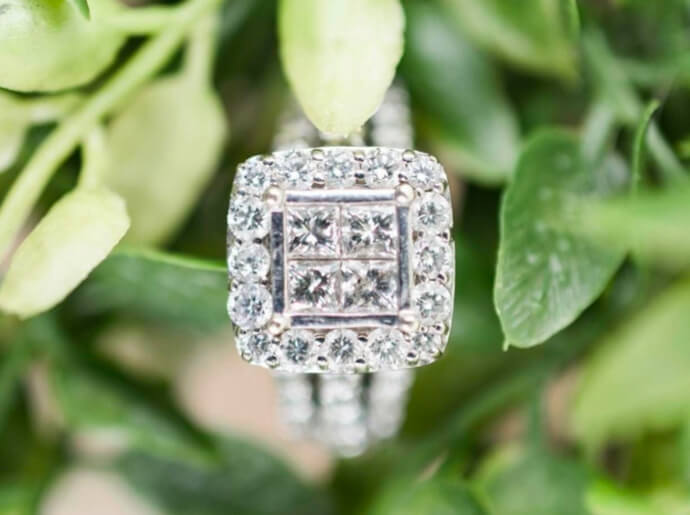
Princess-cut Diamonds Buying Guide
Find out HOW PRINCESS-CUT AND ROUND-CUT DIAMONDS COMPARE
Shopping for a diamond engagement ring? Congrats! The first step to finding your ideal ring starts with selecting a diamond shape. Princess-cut diamonds and round-cut diamonds are the two most popular diamond shapes out there—but how do they compare? Learn more about the key differences between princess-cut and round-cut diamonds, so you can choose the shape that’s right for you.
Princess-cut diamonds feature a square or slightly rectangular face with four pointed corners and a side profile that resembles an inverted pyramid.
Round-cut diamonds feature a round face and a classic side profile—undoubtedly the most widely recognized of all diamond shapes.
Even though it wasn’t developed until the 1970s, the princess-cut diamond has quickly grown in appeal as the second-most popular diamond shape. Princess-cut diamonds are celebrated for their modern, on-trend look.
The round-cut diamond is by far the most popular of all diamond shapes. First introduced in the mid-17th century, the round-cut diamond is widely coveted as a timeless classic.
As a relatively new diamond shape, the princess-cut diamond is admired for bringing a more contemporary, geometrical look to traditional diamond jewelry. Its crisp lines and square shape also give it the optical illusion of appearing larger than a round-cut diamond of the same carat weight.
The softer, traditional shape and longstanding admiration of the round-cut diamond gives it a timeless feel. Round-cut diamonds have been in style for centuries, making them a classic choice that can be treasured and handed down for generations to come.
Princess-cut diamonds typically cost less per carat than a round cut-diamond. This is because the princess-cut shape already mimics the shape of a rough diamond, and therefore doesn’t require as much material to be removed from the rough diamond during the cutting process. A princess-cut diamond retains about 80% of the rough diamond.
Round-cut diamonds, on the other hand, require a lot more material to be removed from the rough stone to create their shape. A round-cut diamond will only retain about 40% of the rough diamond after the cutting process.
Since the four sharp corners of a princess-cut diamond can be vulnerable to chipping, a bezel or four-prong ring setting will help keep the stone protected and hold it securely in place.
Although they are less prone to chipping, round-cut diamond engagement rings also lend well to bezel or four-prong ring settings. Larger round-cut diamonds may require a six-prong setting to hold the stone securely in place.
Some of the most popular settings for both princess-cut and round-cut diamond engagement rings include:
| KAY Diamond Comparison | Princess-cut Diamonds | Round-cut Diamonds |
|---|---|---|
| Shape | Square | Round |
| Popularity | Second-most popular | Most popular |
| Style | Modern, on-trend | Traditional, timeless |
| Price Comparison (of comparable quality and size) | $$ | $$$ |
| Independently Certified | Yes* | Yes* |
| 100% Conflict-Free | Yes | Yes |
| KAY Responsible Sourcing Commitment | Yes | Yes |
| Industry Sourcing Standards Established | Yes | Yes |
| Included in the Lifetime Diamond Commitment | Yes | Yes |
| Eligible for Trade-In | Yes | Yes |
| *Select styles & carat weights | ||
Celebrate your love with a diamond that tells your unique story. Explore KAY’s selection of princess-cut and round-cut diamond rings now to find the style that speaks to you.
Not sure which diamond cut is right for you? Connect with KAY for one-on-one expert advice! Simply book a virtual or in-store appointment at a set time convenient for you.
Diamond Education from the Experts
KAY’s Jewelry Library is your one-stop resource for jewelry education! Our collection of articles includes everything from jewelry basics, style guides, shopping tips, and gift-giving advice to ideas and inspiration for your milestone moments.